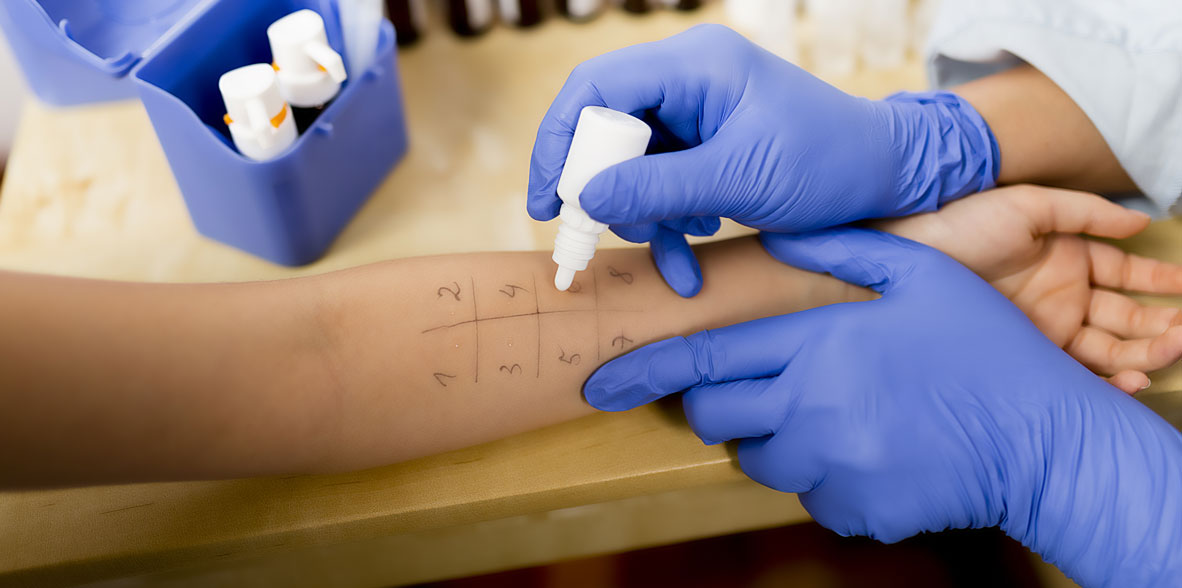

 Centro Médico Teknonen/health-centers/centro-medico-teknon
Centro Médico Teknonen/health-centers/centro-medico-teknon- Centro Médico Teknonen/health-centers/centro-medico-teknon
- Centro Médico Teknonen/health-centers/centro-medico-teknon
 Centro Médico Teknonen/health-centers/centro-medico-teknon
Centro Médico Teknonen/health-centers/centro-medico-teknon
What are urticaria and angioedema?
Urticaria and angioedema are two similar processes due to vascular reactions of the skin in which the permeability of the blood vessels is altered and plasma extravasation occurs causing edema of the affected tissues. If the most superficial layer of the skin (superficial dermis) is affected, the wheal-like rashes typical of urticaria are formed. If deeper layers (deep dermis) are affected, localized swellings are produced. Sometimes both forms of presentation can occur in the same person.
Urticaria is one of the most common skin affections since between 15 to 20% of the population suffers some episode during their lifetime and between 5 and 25% of them are recurrent. Young women are the most affected by urticaria.
- What are the causes of urticaria and angioedema?
The causes of this pathology are very diverse and only a part is due to an allergic reaction. The rest are due to physical agents (cold, heat, sun exposure, pressure, physical exercise), to the direct effect of certain drugs (muscle relaxants, opiates, iodine) or to foods containing high amounts of tyramyra (chocolates, fermented cheeses, wines). Some food additives such as sulfites and benzoates can also cause urticaria by direct, non-immunological effect.
There are urticaria accompanying some serious diseases such as cancer or vasculitis. There are also hereditary forms with autosomal dominant inheritance, which affect families and are due to the deficiency of some plasma proteins.
Among the urticarias that have an immunological basis the most frequent are those mediated by immunoglobulin E (IgE) or allergic urticarias triggered by food (milk, eggs, nuts, seafood, etc.), by drugs (penicillin, non-steroidal anti-inflammatory drugs-NSAIDs and others). In some cases inhaled allergens (aeroallergens) can trigger urticaria and also skin contact with some plants (parietaria, grasses, etc.).
Other causes are infections by some parasites and insect bites, mainly hymenoptera.
- How do urticaria and angioedema present?
 Lip edemaThey can present acutely, with sudden onset and may be self-limited (hours, days) or persist and become chronic.
Lip edemaThey can present acutely, with sudden onset and may be self-limited (hours, days) or persist and become chronic.Urticaria is considered chronic if the eruptive episodes are daily or very close together and last 8 weeks or more.
As mentioned above, some patients present only urticaria: a pink or whitish wheal with a reddish halo, sometimes confluent with others giving large plaques. Due to scratching or spontaneously, they may present purpuric appearance. The dominant symptom is itching that worsens at night and is located anywhere on the body.
Angioedema presents as a swollen, swollen, hard, localized and asymmetric swollen area without inflammatory signs, producing pain or burning sensation. It is localized on the face (eyelids, lips), extremities and scalp, palms of the hands and soles of the feet. If the submucosa of the respiratory or digestive tract is affected, more severe breathing and swallowing disorders may occur.
- How are urticaria and angioedema diagnosed?
As always, the clinical history is essential and the direct observation of the lesions. Nowadays, with the ease of digital photography, many times the patient provides photographs of the acute episode or its evolution over time.
It is always necessary to rule out that the process is part of a general disease such as lymphoma, arthritis, thyroiditis or autoimmune disease. A family history is also important to rule out hereditary urticaria.
A fundamental chapter is the constitutional study to determine other types of allergies (respiratory, food allergies), history of drug use, etc.
It is very important to perform a complete analysis looking for allergy markers, immunological alterations and also to perform urinalysis, stool analysis and sinus x-rays to rule out chronic sinusitis. Sometimes it is necessary to perform a skin biopsy if vasculitis is suspected and in chronic urticaria resistant to treatment.
Once the diagnosis of possible allergic urticaria has been made and if the patient is in remission and without antihistamines, skin tests with aeroallergens, food and if necessary oral provocation tests with food additives will be performed.
Overall it should be considered that the causal diagnosis of urticaria-angioedema, especially in chronic forms, is complex and it is accepted that in 70% of cases it is not possible to identify what causes it. - What is the treatment of urticaria and angioedema?
Whenever a factor responsible for urticaria is detected, you should seek its elimination and avoid contact. This is particularly important in urticaria caused by drugs, foods and additives.
The basic treatment of urticaria is H1 antihistamines, of which there are different groups with sedative or non-sedative effect and with prolonged or short effect. In some cases they are associated with H2 receptor blockers such as ranitidine.
In angioedema and acute generalized urticaria presenting to the emergency department, the administration of corticosteroids by i/m route (methylprednisolone) is common. It is administered orally in patients who are difficult to control with antihistamines.Other drugs may be administered depending on the clinical case and the general assessment of the patient.
- What is dermographism?
 Dermographism is a cutaneous hyperreactivity that is triggered after a mechanical stimulus of the skin (rubbing, scratching, pressure) and manifests as a linear wheal surrounded by redness (erythema). Part of the general population may present this skin disorder.
Dermographism is a cutaneous hyperreactivity that is triggered after a mechanical stimulus of the skin (rubbing, scratching, pressure) and manifests as a linear wheal surrounded by redness (erythema). Part of the general population may present this skin disorder.



































